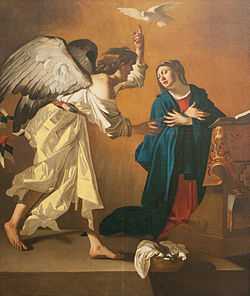Jan Janssens


Jan Janssens (also Johannes Janssens and Joannes Janssens[1]) (August 1590, Ghent – after 1650) was a Flemish Baroque painter and draftsman who is considered to be the most important of the so-called Ghent Caravaggisti.[2]
Biography
There is no information available about Jan Janssens’ training. He was in Rome in the period 1619-1620. Janssens returned to Ghent in 1621 and was admitted to the Ghent Guild of St. Luke as a master. From 1634-1635 and in 1646 Janssens was dean of the Ghent Guild of St. Luke.[3] On 29 August 1623, he married Petronilla de Rop with whom he had 6 children.[3]
Works
During his stay in Italy Janssens came in contact with Dutch painters like Dirck Van Baburen, Gerard van Honthorst and Hendrick ter Brugghen who were followers of the style of Caravaggio and are known as the Dutch or Utrecht Caravaggisti, after their main centre in Utrecht, where there was still a sizeable and prosperous Catholic population. Their work influenced him stylistically.[4] He was also influenced by the work of Bartolomeo Manfredi. Janssens took the Caravaggio style back with him to Ghent, where he mainly received commissions for altarpieces.
His chief subject matter are biblical and, to a lesser extent, mythological[1] themes painted in a large format. His favourite themes are Christ crowned with thorns and the mockery of Christ. Janssens's work conforms to the prescriptions of the Counter Reformation and the Baroque through its merciless and sober realism and dramatic effects with hidden light that shines on his figures.[3] The purpose of the paintings was to have a strong emotional impact on the viewer.
One of his masterpieces is The Martyrdom of Saint Barbara (which in fact deals with Saint Agatha) kept in the Saint Michael's Church, Ghent.[3]
References
| Wikimedia Commons has media related to Jan Janssens. |
Bibliography
- D. Roggen, H. Pauwels, A. de Schryver, Het Caravaggisme te Gent, Gentse Bijdragen tot de kunstgeschiedenis 12 (1949-1950), p. 255-321 (in Dutch)
- D. Roggen, H. Pauwwels, Nog bij Het Caravaggisme te Gent. Gentse Bijdragen tot de kunstgeschiedenis 14 (1953), p. 201-205 (in Dutch)